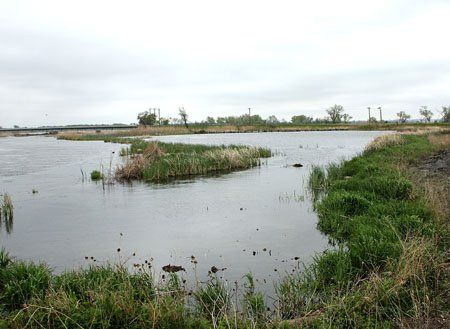
© NP TelegraphThe North Platte River is expected to reach record levels this month.
A storm system slowly meandering from the central Rockies into the Plains could bring heavy rain to parts of Nebraska on Thursday, with rain chances continuing into next week.
AccuWeather said cool air arriving on the southern Plains with this system will clash with warmer, moist air flowing in from the Gulf of Mexico, setting the stage for hit-and-miss storms with heavy rain, large hail and wind gusts past 40 mph.
Some isolated tornadoes cannot be ruled out from the strongest of storms, forecasters said.
For Southeast Nebraska, the strongest chances for severe storms, with large hail and damaging winds, appear to be Thursday night, then again Friday afternoon and evening, the weather service said. The National Weather Service said Lincoln had a 60 to 80 percent chance of rain Thursday and Friday.
A flash flood watch was in effect for parts of southwest Nebraska on Thursday.
State climatologist Al Dutcher said Wednesday that forecast models have shown an above-normal precipitation trend for Nebraska.
Right now, he said in a news release, farmers are hoping the rain holds off for planting.
"Rains are important, but we'd like to see them spaced out a bit," Dutcher said.
As of Wednesday afternoon, Lincoln's precipitation since Jan. 1 was more than 2 inches below normal. Light rain was falling Thursday morning.
In western Nebraska, with the North Platte River already running full to overflowing in several counties, Dutcher said heavy snowpack in the Rocky Mountains is a big concern for the Platte this spring, and it hasn't even started to melt yet.
Runoff from Rocky Mountain snowpack is projected at nearly 2 million acre feet of water -- an increase of 500,000 acre feet from a projection a month ago, he said.
"If it remains cool over the Rockies, snow melt will be slow. However, a major fear is that an extended rain event falls on the snow or conditions turn hot over the mountains and ramps up runoff," Dutcher said.
That could lead to flooding, he said.
The Central Nebraska Public Power and Irrigation District based in Holdrege plans to step up releases from Lake McConaughy this week to 4,000 cubic feet per second.
The Platte River height at North Platte is 7 feet; the local flood level is 6 feet.
"This most likely will exceed record stage set in 1971, which was 7.1 feet," Dutcher said.
In addition, Glendo, Pathfinder and Seminoe reservoirs upstream in Wyoming are releasing water. While reservoirs upstream were full last fall, Seminoe has been dropped to 38 percent of capacity in anticipation of the snow melt, Dutcher said.
Inflows there are averaging 5,000 cfs and likely will increase to 15,000 cfs within the next 20 days. At that rate, it would take less than two weeks to fill.
While everything is being done to minimize flooding, Dutcher said, there is still concern over South Platte River flows.

Reader Comments
to our Newsletter